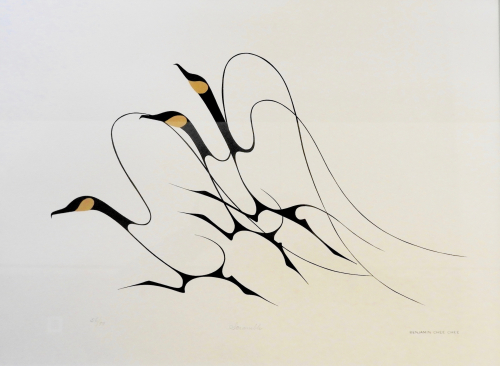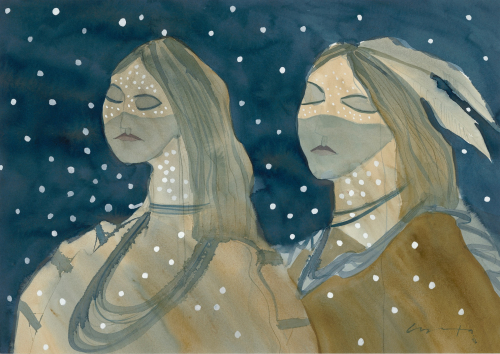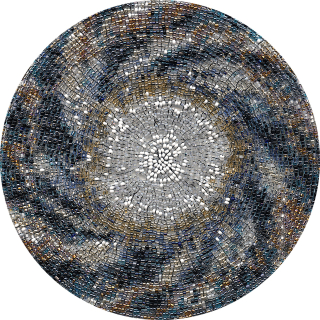The First Nations collection includes a wide range of artworks by Indigenous artists from Canada, as well as a selection by international Indigenous artists. The McGill Visual Arts Collection is committed to strengthening local, contemporary Indigenous art practices in Canada and is actively working to increase the diversity and visibility of Indigenous art across all campuses.

Benjamin Chee Chee (1944-1977) was an Ojibwe artist from Ontario and a member of the second generation of the Woodland School of Art. Despite being a member of the Woodland School, he had his own personal workspace and developed a unique, more modern, graphic style.
Chee Chee gained fame with his minimalistic and graceful depictions of birds and animals. Geese such as the ones presented in this print are among his most widely recognized motifs. Typically pictured in black and yellow, he has drawn them in a myriad of motions: taking off, flapping, turning, looking, and flying.

Leo Yerxa (1947-2017) was an Ojibwe visual artist and writer, mostly recognized for his illustrated picture books destined to children. Born on the Little Eagle Reserve, Couchiching First Nation, in northwestern Ontario, Yerxa studied graphic arts at Algonquin College as well as fine arts at the University of Waterloo. He received the Governor General’s Award for Illustration in 1996 for his critically acclaimed book Ancient Thunder.
This watercolour presents two figures, eyes closed, and face-tilted slightly upwards, standing under a navy sky from which snow is falling. Imbued with a sense of spirituality and strength, the atmospheric quality of the painting is typical of Yerxa’s work.

Nadia Myre (1974-) is a contemporary artist and a member of the Kitigan Zibi Anishinabeg First Nation. Her interdisciplinary work encompasses themes of identity, resilience, politics, language, and loss. Now living and working in Montreal, Myre studied art at Camosun College, Emily Carr University of Art and Design, and Concordia University. Very active on the Canadian art scene, her works are collected by and exhibited in some of the country’s most prestigious institutions, namely the National Gallery of Canada, the Montreal Museum of Fine Arts, the Musée National des Beaux-Arts du Québec, the Canadian Museum of History, and the Musée des civilizations (Quebec). Nadia Myre has also participated in a number of international exhibitions, including at the Museum of Art and Design in New York, the National museum of the American Indian Act in New York, the 2012 Biennale of Sydney and the 2014 Biennale of Shanghai.
A continuation of her beaded series Meditations on Black (2012) and Meditations on Red (2013), Meditations Respite (03) is inspired by the imagery from our solar system and explores the question of the afterlife. The work is meant to evoke the mystery of the universe and the infinite nature of the systems that make up our surroundings.